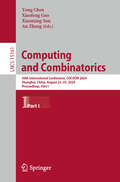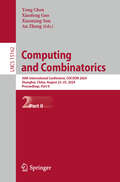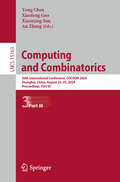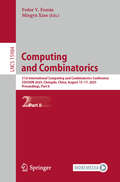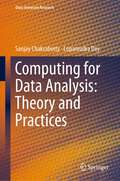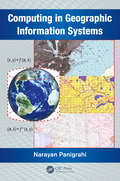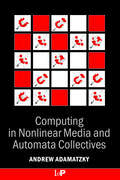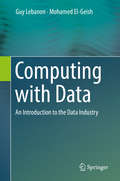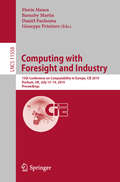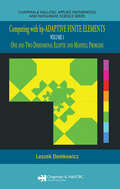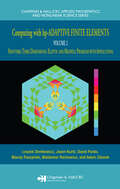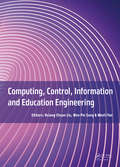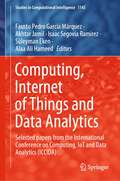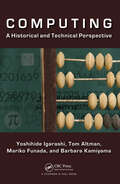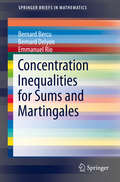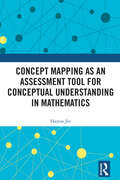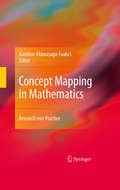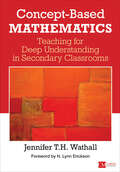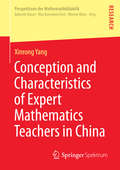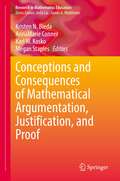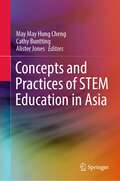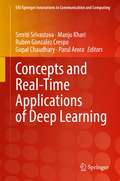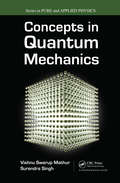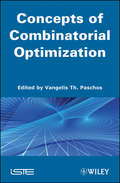- Table View
- List View
Computing and Combinatorics: 30th International Conference, COCOON 2024, Shanghai, China, August 23–25, 2024, Proceedings, Part I (Lecture Notes in Computer Science #15161)
by Yong Chen Xiaofeng Gao Xiaoming Sun An ZhangThis three-volume set LNCS 15161, 15162 and 15163 constitutes the refereed proceedings of the 30th International Conference, COCOON 2024, held in Shanghai, China, during August 23–25, 2024. The 90 full papers and 6 short papers were carefully reviewed and selected from 277 submissions. COCOON 2024 provided an excellent venue for researchers working in the area of algorithms, theory of computation, computational complexity, and combinatorics related to computing.
Computing and Combinatorics: 30th International Conference, COCOON 2024, Shanghai, China, August 23–25, 2024, Proceedings, Part II (Lecture Notes in Computer Science #15162)
by Yong Chen Xiaofeng Gao Xiaoming Sun An ZhangThis three-volume set LNCS 15161, 15162 and 15163 constitutes the refereed proceedings of the 30th International Conference, COCOON 2024, held in Shanghai, China, during August 23–25, 2024. The 90 full papers and 6 short papers were carefully reviewed and selected from 277 submissions. COCOON 2024 provided an excellent venue for researchers working in the area of algorithms, theory of computation, computational complexity, and combinatorics related to computing.
Computing and Combinatorics: 30th International Conference, COCOON 2024, Shanghai, China, August 23–25, 2024, Proceedings, Part III (Lecture Notes in Computer Science #15163)
by Yong Chen Xiaofeng Gao Xiaoming Sun An ZhangThis three-volume set LNCS 15161, 15162 and 15163 constitutes the refereed proceedings of the 30th International Conference, COCOON 2024, held in Shanghai, China, during August 23–25, 2024. The 90 full papers and 6 short papers were carefully reviewed and selected from 277 submissions. COCOON 2024 provided an excellent venue for researchers working in the area of algorithms, theory of computation, computational complexity, and combinatorics related to computing.
Computing and Combinatorics: 31st International Computing and Combinatorics Conference, COCOON 2025, Chengdu, China, August 15–17, 2025, Proceedings, Part II (Lecture Notes in Computer Science #15984)
by Mingyu Xiao Fedor V. FominThis two-volume set, LNCS 15983 and 15984, constitutes the referred proceedings of the 31st International Computing and Combinatorics Conference, COCOON 2025, held in Chengdu, China, during August 15–17, 2025. The 54 full papers were carefully reviewed and selected from 191 submissions. COCOON 2025 provided an excellent venue for researchers working in the topical sections as follows:Part I: Approximation Algorithms, Combinatorial Optimization, Computational Complexity, Computational Geometry, Economics and Computation.Part II: Graph Algorithms and Graph Theory, Learning and Data-Related Theory, Parameterized Algorithms, String Algorithms and Discrete Structures.
Computing for Data Analysis: Theory and Practices (Data-Intensive Research)
by Sanjay Chakraborty Lopamudra DeyThis book covers various cutting-edge computing technologies and their applications over data. It discusses in-depth knowledge on big data and cloud computing, quantum computing, cognitive computing, and computational biology with respect to different kinds of data analysis and applications. In this book, authors describe some interesting models in the cloud, quantum, cognitive, and computational biology domains that provide some useful impact on intelligent data (emotional, image, etc.) analysis. They also explain how these computing technologies based data analysis approaches used for various real-life applications. The book will be beneficial for readers working in this area.
Computing in Geographic Information Systems
by Narayan PanigrahiCapable of acquiring large volumes of data through sensors deployed in air, land, and sea, and making this information readily available in a continuous time frame, the science of geographical information system (GIS) is rapidly evolving. This popular information system is emerging as a platform for scientific visualization, simulation, and computa
Computing in Nonlinear Media and Automata Collectives
by Andrew AdamatzkyComputing in Nonlinear Media and Automata Collectives presents an account of new ways to design massively parallel computing devices in advanced mathematical models, such as cellular automata and lattice swarms, from unconventional materials, including chemical solutions, bio-polymers, and excitable media.
Computing with Data: An Introduction to the Data Industry
by Guy Lebanon Mohamed El-GeishThis book introduces basic computing skills designed for industry professionals without a strong computer science background. Written in an easily accessible manner, and accompanied by a user-friendly website, it serves as a self-study guide to survey data science and data engineering for those who aspire to start a computing career, or expand on their current roles, in areas such as applied statistics, big data, machine learning, data mining, and informatics. The authors draw from their combined experience working at software and social network companies, on big data products at several major online retailers, as well as their experience building big data systems for an AI startup. Spanning from the basic inner workings of a computer to advanced data manipulation techniques, this book opens doors for readers to quickly explore and enhance their computing knowledge. Computing with Data comprises a wide range of computational topics essential for data scientists, analysts, and engineers, providing them with the necessary tools to be successful in any role that involves computing with data. The introduction is self-contained, and chapters progress from basic hardware concepts to operating systems, programming languages, graphing and processing data, testing and programming tools, big data frameworks, and cloud computing. The book is fashioned with several audiences in mind. Readers without a strong educational background in CS--or those who need a refresher--will find the chapters on hardware, operating systems, and programming languages particularly useful. Readers with a strong educational background in CS, but without significant industry background, will find the following chapters especially beneficial: learning R, testing, programming, visualizing and processing data in Python and R, system design for big data, data stores, and software craftsmanship.
Computing with Foresight and Industry: 15th Conference on Computability in Europe, CiE 2019, Durham, UK, July 15–19, 2019, Proceedings (Lecture Notes in Computer Science #11558)
by Giuseppe Primiero Florin Manea Barnaby Martin Daniël PaulusmaThis book constitutes the refereed proceedings of the 15th Conference on Computability in Europe, CiE 2019, held in Durham, UK, in July 2019.The 20 revised full papers presented were carefully reviewed and selected from 35 submissions. In addition, this volume includes 7 invited papers. The conference CiE 2018 had the following six special sessions: computational neuroscience, history and philosophy of computing, lowness notions in computability, probabilistic programming and higher-order computation, smoothed and probabilistic analysis of algorithms, and transnite computations.
Computing with hp-ADAPTIVE FINITE ELEMENTS: Volume 1 One and Two Dimensional Elliptic and Maxwell Problems (Chapman & Hall/CRC Applied Mathematics & Nonlinear Science)
by Leszek DemkowiczOffering the only existing finite element (FE) codes for Maxwell equations that support hp refinements on irregular meshes, Computing with hp-ADAPTIVE FINITE ELEMENTS: Volume 1. One- and Two-Dimensional Elliptic and Maxwell Problems presents 1D and 2D codes and automatic hp adaptivity. This self-contained source discusses the theory and implementat
Computing with hp-ADAPTIVE FINITE ELEMENTS: Volume II Frontiers: Three Dimensional Elliptic and Maxwell Problems with Applications (Chapman & Hall/CRC Applied Mathematics & Nonlinear Science)
by David Pardo Leszek Demkowicz Maciej Paszynski Jason Kurtz Waldemar Rachowicz Adam ZdunekWith a focus on 1D and 2D problems, the first volume of Computing with hp-ADAPTIVE FINITE ELEMENTS prepared readers for the concepts and logic governing 3D code and implementation. Taking the next step in hp technology, Volume II Frontiers: Three-Dimensional Elliptic and Maxwell Problems with Applications presents the theoretical foundations of the
Computing, Control, Information and Education Engineering: Proceedings of the 2015 Second International Conference on Computer, Intelligent and Education Technology (CICET 2015), April 11-12, 2015, Guilin, P.R. China
by Wen-Pei Sung Hsiang-Chuan Liu Wenli-YaoThis proceedings set contains selected Computer, Information and Education Technology related papers from the 2015 International Conference on Computer, Intelligent Computing and Education Technology (CICET 2015), to be held April 11-12, 2015 in Guilin, P.R. China. The proceedings aims to provide a platform for researchers, engineers and academics
Computing, Internet of Things and Data Analytics: Selected papers from the International Conference on Computing, IoT and Data Analytics (ICCIDA) (Studies in Computational Intelligence #1145)
by Fausto Pedro García Márquez Akhtar Jamil Alaa Ali Hameed Süleyman Eken Isaac Segovia RamirezThis book covers selected papers presented at the 2nd International Conference on Computing, IoT and Data Analytics (ICCIDA) in 2022 organized by Universidad de Castilla - La Mancha, Spain, August 11-12, 2023. It highlights some of the latest research advances and cutting-edge analyses of real-world problems related to Computing, IoT and Data Analytics and their applications in various domains. This includes state of the art models and methods used on benchmark datasets.
Computing: A Historical and Technical Perspective
by Yoshihide Igarashi Tom Altman Mariko Funada Barbara KamiyamaExploring a vast array of topics related to computation, Computing: A Historical and Technical Perspective covers the historical and technical foundation of ancient and modern-day computing. The book starts with the earliest references to counting by humans, introduces various number systems, and discusses mathematics in early civilizations. It gui
Concentration Inequalities for Sums and Martingales (SpringerBriefs in Mathematics)
by Bernard Bercu Bernard Delyon Emmanuel RioThe purpose of this book is to provide an overview of historical and recent results on concentration inequalities for sums of independent random variables and for martingales. The first chapter is devoted to classical asymptotic results in probability such as the strong law of large numbers and the central limit theorem. Our goal is to show that it is really interesting to make use of concentration inequalities for sums and martingales. The second chapter deals with classical concentration inequalities for sums of independent random variables such as the famous Hoeffding, Bennett, Bernstein and Talagrand inequalities. Further results and improvements are also provided such as the missing factors in those inequalities. The third chapter concerns concentration inequalities for martingales such as Azuma-Hoeffding, Freedman and De la Pena inequalities. Several extensions are also provided. The fourth chapter is devoted to applications of concentration inequalities in probability and statistics.
Concept Mapping as an Assessment Tool for Conceptual Understanding in Mathematics
by Haiyue JINThis book investigates the practicability and effectiveness of the concept map as a tool for assessing students’ conceptual understanding in mathematics. The author first introduces concept mapping and then employs it to investigate students’ conceptual understanding of four different mathematical topics. Alongside traditional scoring methods, she adopts Social Network Analysis, a new technique, to interpret student-constructed concept maps, which revealed fresh insights into the graphic features of the concept map and into how students connect mathematical concepts. By comparing two traditional school tests with the concept map, she examines its concurrent validity and discusses its strengths and drawbacks from the viewpoint of assessing conceptual understanding. With self-designed questionnaires, interviews, and open-ended writing tasks, she also investigates students and teachers’ attitudes toward concept mapping and describes the implications these findings may have for concept mapping’s use in school and for further research on the topic. Scholars and postgraduate students of mathematics education and teachers interested in concept mapping or assessing conceptual understanding in classroom settings will find this book an informative, inspiring, and overall valuable addition to their libraries.
Concept Mapping in Mathematics: Research into Practice
by Karoline Afamasaga-Fuata'IConcept Mapping in Mathematics: Research into Practice is the first comprehensive book on concept mapping in mathematics. It provides the reader with an understanding of how the meta-cognitive tool, namely, hierarchical concept maps, and the process of concept mapping can be used innovatively and strategically to improve planning, teaching, learning, and assessment at different educational levels. This collection of research articles examines the usefulness of concept maps in the educational setting, with applications and examples ranging from primary grade classrooms through secondary mathematics to pre-service teacher education, undergraduate mathematics and post-graduate mathematics education. A second meta-cognitive tool, called vee diagrams, is also critically examined by two authors, particularly its value in improving mathematical problem solving. Thematically, the book flows from a historical development overview of concept mapping in the sciences to applications of concept mapping in mathematics by teachers and pre-service teachers as a means of analyzing mathematics topics, planning for instruction and designing assessment tasks including applications by school and university students as learning and review tools. This book provides case studies and resources that have been field tested with school and university students alike. The findings presented have implications for enriching mathematics learning and making problem solving more accessible and meaningful for students. The theoretical underpinnings of concept mapping and of the studies in the book include Ausubel's cognitive theory of meaningful learning, constructivist and Vygotskian psychology to name a few. There is evidence particularly from international studies such as PISA and TIMSS and mathematics education research, which suggest that students' mathematical literacy and problem solving skills can be enhanced through students collaborating and interacting as they work, discuss and communicate mathematically. This book proposes the meta-cognitive strategy of concept mapping as one viable means of promoting, communicating and explicating students' mathematical thinking and reasoning publicly in a social setting (e.g., mathematics classrooms) as they engage in mathematical dialogues and discussions. Concept Mapping in Mathematics: Research into Practice is of interest to researchers, graduate students, teacher educators and professionals in mathematics education.
Concept-Based Mathematics: Teaching for Deep Understanding in Secondary Classrooms (Corwin Mathematics Series)
by Jennifer WathallGive math students the connections between what they learn and how they do math—and suddenly math makes sense If your secondary-school students are fearful of or frustrated by math, it’s time for a new approach. When you teach concepts rather than rote processes, you show students math’s essential elegance, as well as its practicality—and help them discover their own natural mathematical abilities. This book is a road map to retooling how you teach math in a deep, clear, and meaningful way —through a conceptual lens—helping students achieve higher-order thinking skills. Jennifer Wathall shows you how to plan units, engage students, assess understanding, incorporate technology, and even guides you through an ideal concept-based classroom. Practical tools include: Examples from arithmetic to calculus Inquiry tasks, unit planners, templates, and activities Sample assessments with examples of student work Vignettes from international educators A dedicated companion website with additional resources, including a study guide, templates, exemplars, discussion questions, and other professional development activities. Everyone has the power to understand math. By extending Erickson and Lanning’s work on Concept-Based Curriculum and Instruction specifically to math, this book helps students achieve the deep understanding and skills called for by global standards and be prepared for the 21st century workplace. "Jennifer Wathall’s book is one of the most forward thinking mathematics resources on the market. While highlighting the essential tenets of Concept-Based Curriculum design, her accessible explanations and clear examples show how to move students to deeper conceptual understandings. This book ignites the mathematical mind!" — Lois A. Lanning, Author of Designing Concept-based Curriculum for English-Language Arts, K-12 "Wathall is a master at covering all the bases here; this book is bursting with engaging assessment examples, discussion questions, research, and resources that apply specifically to mathematical topics. Any math teacher or coach would be hard-pressed to read it and not come away with scores of ideas, assessments, and lessons that she could use instantly in the classroom. As an IB Workshop Leader and instructional coach, I want this book handy on a nearby shelf for regular referral – it′s a boon to any educator who wants to bring math to life for students." — Alexis Wiggins, Instructional Coach, IB Workshop Leader and Consultant
Concept-Based Mathematics: Teaching for Deep Understanding in Secondary Classrooms (Corwin Mathematics Series)
by Jennifer WathallGive math students the connections between what they learn and how they do math—and suddenly math makes sense If your secondary-school students are fearful of or frustrated by math, it’s time for a new approach. When you teach concepts rather than rote processes, you show students math’s essential elegance, as well as its practicality—and help them discover their own natural mathematical abilities. This book is a road map to retooling how you teach math in a deep, clear, and meaningful way —through a conceptual lens—helping students achieve higher-order thinking skills. Jennifer Wathall shows you how to plan units, engage students, assess understanding, incorporate technology, and even guides you through an ideal concept-based classroom. Practical tools include: Examples from arithmetic to calculus Inquiry tasks, unit planners, templates, and activities Sample assessments with examples of student work Vignettes from international educators A dedicated companion website with additional resources, including a study guide, templates, exemplars, discussion questions, and other professional development activities. Everyone has the power to understand math. By extending Erickson and Lanning’s work on Concept-Based Curriculum and Instruction specifically to math, this book helps students achieve the deep understanding and skills called for by global standards and be prepared for the 21st century workplace. "Jennifer Wathall’s book is one of the most forward thinking mathematics resources on the market. While highlighting the essential tenets of Concept-Based Curriculum design, her accessible explanations and clear examples show how to move students to deeper conceptual understandings. This book ignites the mathematical mind!" — Lois A. Lanning, Author of Designing Concept-based Curriculum for English-Language Arts, K-12 "Wathall is a master at covering all the bases here; this book is bursting with engaging assessment examples, discussion questions, research, and resources that apply specifically to mathematical topics. Any math teacher or coach would be hard-pressed to read it and not come away with scores of ideas, assessments, and lessons that she could use instantly in the classroom. As an IB Workshop Leader and instructional coach, I want this book handy on a nearby shelf for regular referral – it′s a boon to any educator who wants to bring math to life for students." — Alexis Wiggins, Instructional Coach, IB Workshop Leader and Consultant
Conception and Characteristics of Expert Mathematics Teachers in China (Perspektiven der Mathematikdidaktik)
by Xinrong YangThe superior performance of East Asian students in recent internationalstudies of mathematics achievement has attracted the attention of educators and policy makers worldwide. Xinrong Yang focuses on exploring how an expert mathematics teacher is conceptualized by mathematics educators in China and the characteristics that expert mathematics teachers share. The author adopts a sociocultural theory and a prototypical view of conception in this study of teacher expertise and shows that some of the roles expected to be played by expert mathematics teachers in China, such as being at the same time aresearcher, a mentor, an expert in examination, and an exemplary model, are quite different from the roles expected of an expert teacher in Western cultures. In addition, some characteristics of expert mathematics teachers the author identifies are different from those reported in previous studies. Examples include the expert mathematics teachers´ contemporary-constructivist oriented beliefs aboutmathematics and its learning and teaching, and their ability to teach withflexibility, balance, and coherence.
Conceptions and Consequences of Mathematical Argumentation, Justification, and Proof (Research in Mathematics Education)
by Kristen N. Bieda AnnaMarie Conner Karl W. Kosko Megan StaplesThis book aims to advance ongoing debates in the field of mathematics and mathematics education regarding conceptions of argumentation, justification, and proof and the consequences for research and practice when applying particular conceptions of each construct. Through analyses of classroom practice across grade levels using different lenses - particular conceptions of argumentation, justification, and proof - researchers consider the implications of how each conception shapes empirical outcomes. In each section, organized by grade band, authors adopt particular conceptions of argumentation, justification, and proof, and they analyse one data set from each perspective. In addition, each section includes a synthesis chapter from an expert in the field to bring to the fore potential implications, as well as new questions, raised by the analyses. Finally, a culminating section considers the use of each conception across grade bands and data sets.
Concepts and Practices of STEM Education in Asia
by Alister Jones Cathy Buntting May May Hung ChengThe purpose of this edited book is to enrich the literature related to STEM education at kindergarten, primary and secondary levels in Asia, with particular attention given to the analysis of the educational context in a number of Asian countries, including STEM-related policies, pedagogical practices, and the design and evaluation of STEM programmes. The discussions look into impacts on student learning outcomes and the ways in which STEM education is catering for schools and students’ interests and needs. The contributors are experts in STEM education or are leading major research and development projects in STEM in their regions. The book’s first section is focused at the macro-level on the conceptualization and formulation of STEM education policies in different regions, contributing to our understanding of the current status of STEM education in Asia. The second section examines some features of STEM learning and teaching at the classroom level and includes studies on student learning in STEM programmes. Pedagogical innovations implemented in different parts of Asia are also reported and discussed. The third section moves to teacher education and teacher professional development. It discusses practices of teacher professional development in the region and reports on current provisions as well as challenges. Together, the contributions from different Asian regions invite researchers and educators to learn from effective STEM practices, and point out areas for further development.Chapters "An Overview of STEM Education in Asia" and "STEM Teacher Professional Development for Primary School Teachers in Hong Kong" are available open access under a CC BY 4.0 license at link.springer.com.
Concepts and Real-Time Applications of Deep Learning (EAI/Springer Innovations in Communication and Computing)
by Smriti Srivastava Manju Khari Gopal Chaudhary Ruben Gonzalez Crespo Parul AroraThis book provides readers with a comprehensive and recent exposition in deep learning and its multidisciplinary applications, with a concentration on advances of deep learning architectures. The book discusses various artificial intelligence (AI) techniques based on deep learning architecture with applications in natural language processing, semantic knowledge, forecasting and many more. The authors shed light on various applications that can benefit from the use of deep learning in pattern recognition, person re-identification in surveillance videos, action recognition in videos, image and video captioning. The book also highlights how deep learning concepts can be interwoven with more modern concepts to yield applications in multidisciplinary fields.Presents a comprehensive look at deep learning and its multidisciplinary applications, concentrating on advances of deep learning architectures;Includes a survey of deep learning problems and solutions, identifying the main open issues, innovations and latest technologies;Shows industrial deep learning in practice with examples/cases, efforts, challenges, and strategic approaches.
Concepts in Quantum Mechanics (Pure and Applied Physics)
by Vishnu S. Mathur Surendra SinghTaking a conceptual approach to the subject, Concepts in Quantum Mechanics provides complete coverage of both basic and advanced topics. Following in the footsteps of Dirac's classic work Principles of Quantum Mechanics, it explains all themes from first principles.The authors present alternative ways of representing the state of a physical system,
Concepts of Combinatorial Optimization (Wiley-iste Ser.)
by Vangelis Th. PaschosCombinatorial optimization is a multidisciplinary scientific area, lying in the interface of three major scientific domains: mathematics, theoretical computer science and management. The three volumes of the Combinatorial Optimization series aims to cover a wide range of topics in this area. These topics also deal with fundamental notions and approaches as with several classical applications of combinatorial optimization. Concepts of Combinatorial Optimization, is divided into three parts: On the complexity of combinatorial optimization problems, that presents basics about worst-case and randomized complexity; Classical solution methods, that presents the two most-known methods for solving hard combinatorial optimization problems, that are Branch-and-Bound and Dynamic Programming; Elements from mathematical programming, that presents fundamentals from mathematical programming based methods that are in the heart of Operations Research since the origins of this field.
